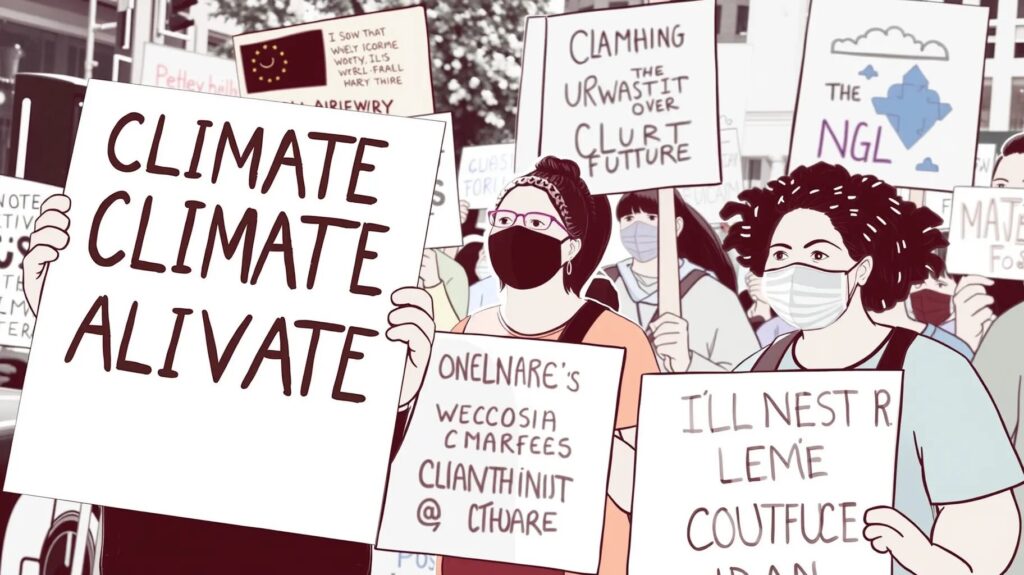
The Rise of AI in Climate Activism
The advent of AI is transforming the landscape of climate activism, ushering in a new era where data-driven insights amplify the power of grassroots movements. As the climate crisis intensifies, activists increasingly turn to AI tools to enhance their efforts, making their campaigns more efficient, targeted, and impactful. What was once a field dominated by passionate voices is now being complemented by cutting-edge technology, providing activists with the means to analyze vast amounts of environmental data, predict outcomes, and influence policy decisions with unprecedented precision.
This shift towards AI-driven activism is not just a trend; it’s a necessary evolution. Climate change is a complex, multifaceted issue that requires equally sophisticated tools to address it effectively. By leveraging AI, activists can better understand the environmental challenges they face, identify the most pressing issues, and deploy resources in the most effective ways possible. This new era of climate activism is characterized by its ability to merge the power of human passion with the precision of machine learning, creating a formidable force in the fight against climate change.
Harnessing Data to Mobilize Communities
One of the most powerful applications of AI in climate activism is its ability to harness and interpret massive datasets to mobilize communities. Activists can now use AI to analyze social media trends, public sentiment, and local environmental data to identify areas where climate issues resonate most. This targeted approach allows them to engage communities more effectively, tailoring their messaging and actions to the specific concerns and needs of each group.
AI also enables activists to predict and model the potential impacts of various climate initiatives, helping communities understand the tangible benefits of their involvement. For example, AI models can show how reducing local carbon emissions might improve air quality, health outcomes, or even economic opportunities. This data-driven approach makes the case for action more compelling, turning abstract concepts into relatable, actionable information.
Moreover, AI tools can assist in organizing and coordinating efforts on a scale that would be impossible manually. By automating tasks such as petition distribution, event planning, and volunteer management, AI frees up activists to focus on strategy and engagement, maximizing the impact of their efforts.
AI in Tracking Pollution: Precision at Scale
Pollution tracking is another area where AI is making significant strides, bringing unprecedented precision and scale to efforts that were once painstakingly slow and limited in scope. Traditional methods of pollution monitoring often rely on a small number of physical sensors, which can only cover limited areas. AI, however, allows for the integration of data from a wide variety of sources—satellite imagery, drones, mobile devices, and even social media posts—creating a comprehensive and real-time picture of pollution levels across vast regions.
This ability to track pollution more accurately and in real time is a game-changer for environmental activism. With AI, activists can identify pollution hotspots, track trends over time, and pinpoint the sources of contamination. This data can then be used to pressure corporations and governments to take action, providing irrefutable evidence of environmental harm and its consequences.
AI-powered pollution tracking is not just about identifying problems, though. It’s also about providing solutions. By analyzing pollution data, AI can help activists develop strategies to reduce emissions, clean up polluted areas, and prevent future environmental damage. This proactive approach turns AI from a mere diagnostic tool into a powerful weapon in the fight against pollution.
From Data to Action: Advocating for Policy Changes with AI
AI’s capacity to process and analyze complex data sets is invaluable when it comes to advocating for policy changes. Activists can now use AI-generated reports and visualizations to make compelling cases to policymakers, backed by hard data and predictive models. This is particularly important in a field where scientific evidence often struggles to cut through the noise of political debate and vested interests.
For example, AI can model the long-term economic impacts of climate inaction versus the benefits of investing in green technologies. These models can provide policymakers with clear, data-driven arguments that resonate with their priorities, whether they are economic growth, public health, or national security. By presenting climate action as not just an environmental imperative but also a smart, pragmatic policy choice, activists can gain support from a broader range of stakeholders.
AI also helps in monitoring the implementation of climate policies once they are in place. Through continuous data collection and analysis, AI can track whether policies are achieving their intended effects or if they need adjustments. This ongoing feedback loop ensures that climate policies are not just well-intentioned but also effective, driving real progress in the fight against climate change.
Empowering Local Voices Through AI-Driven Platforms
AI-driven platforms are playing a crucial role in amplifying local voices, particularly those in communities most affected by climate change. These platforms allow activists to share their stories, connect with others facing similar challenges, and access the tools and data they need to advocate for change. By democratizing access to information and resources, AI is helping to level the playing field, ensuring that even the smallest voices can be heard in the global climate conversation.
For instance, AI-powered platforms can translate complex scientific data into accessible, user-friendly formats that local communities can use to understand their environmental challenges better. These platforms can also facilitate collaboration between activists across different regions, enabling them to share strategies, resources, and successes. This global network of AI-enhanced activists is more connected, informed, and capable than ever before, making it a powerful force for change.
Moreover, AI tools can help local activists gather and analyze their own data, empowering them to take ownership of their environmental challenges. Whether it’s monitoring local pollution levels, tracking the effects of climate change on their crops, or organizing grassroots campaigns, AI gives these communities the tools they need to fight for their futures. In this way, AI is not just supporting grassroots movements—it’s transforming them.
Bridging the Gap: AI Accessibility in Grassroots Movements
While AI offers powerful tools for climate activism, one of the significant challenges is ensuring these technologies are accessible to all. Many grassroots movements operate on limited budgets and may lack the technical expertise required to deploy advanced AI tools effectively. This digital divide can lead to disparities in how different communities can leverage AI for climate action, potentially leaving the most vulnerable groups behind.
To address this issue, there is a growing emphasis on developing user-friendly AI tools and platforms that require minimal technical knowledge. Open-source AI projects and partnerships between tech companies and environmental organizations are helping to bridge the gap, providing activists with the resources they need without requiring deep technical expertise. Training programs and workshops are also crucial in empowering activists with the skills necessary to harness AI’s potential, ensuring that the benefits of AI-driven activism are not limited to those with significant resources.
Moreover, ensuring that AI tools are available in multiple languages and tailored to the specific needs of different communities is essential for making them truly inclusive. By prioritizing accessibility, the climate activism movement can ensure that AI serves as a tool for all, not just the tech-savvy few.
Balancing Tech with Tradition: Integrating AI in Activist Strategies

As AI becomes increasingly integrated into climate activism, it’s essential to balance these new tools with traditional activist strategies that have been effective for decades. While AI can enhance the reach and impact of a movement, it should not replace the human element that is at the heart of all successful activism.
Traditional methods like protests, petitions, and community organizing remain vital, as they provide a personal touch that AI cannot replicate. These approaches build trust, foster community solidarity, and allow for emotional engagement—elements that are crucial for mobilizing people around a cause. AI can complement these efforts by providing data-driven insights, optimizing logistics, and amplifying messages, but the core of activism must remain human.
Moreover, integrating AI into activist strategies requires careful consideration of how technology is perceived by the public. There is a risk that over-reliance on AI could be seen as cold or impersonal, potentially alienating supporters. Therefore, activists must find a balance, using AI to enhance their efforts without overshadowing the grassroots spirit that drives their movements.
Data Privacy Concerns: A Double-Edged Sword in AI Activism
As climate activists increasingly turn to AI, data privacy has emerged as a critical concern. AI tools often rely on large datasets, including sensitive information such as location data, personal details, and even social media activity. While this data is invaluable for driving effective activism, it also raises significant privacy risks.
For instance, the same data that allows activists to track pollution or mobilize communities can also be misused by governments or corporations to surveil activists or suppress dissent. This potential for misuse makes it essential for activists to be aware of the privacy implications of the AI tools they use and to advocate for strong data protection measures.
To mitigate these risks, activists are increasingly turning to privacy-preserving AI technologies. These include methods like differential privacy, which allows data to be used for analysis without exposing individual identities, and encrypted data storage, which protects sensitive information from unauthorized access. By adopting these technologies, activists can continue to leverage AI’s power while safeguarding the privacy of those they aim to protect.
However, data privacy is a double-edged sword. While protecting personal data is crucial, excessive caution can limit the effectiveness of AI-driven activism. Finding the right balance between data utility and privacy is a challenge that activists must navigate carefully.
Case Studies: AI-Driven Climate Success Stories
The impact of AI in climate activism can be seen in various success stories from around the world. For example, AI-driven tools have been used in Brazil to monitor and combat illegal deforestation in the Amazon rainforest. By analyzing satellite imagery and predicting where illegal logging is likely to occur, activists have been able to intervene more quickly and effectively, preventing further environmental damage.
In India, AI has been used to optimize renewable energy usage in rural communities, helping to reduce reliance on fossil fuels and lower carbon emissions. By analyzing energy consumption patterns and predicting future needs, AI has enabled these communities to implement more sustainable energy practices, contributing to the global fight against climate change.
These examples illustrate how AI can be a powerful force for good in the hands of climate activists. By providing the tools to monitor environmental threats, optimize resources, and predict future challenges, AI is helping activists around the world achieve tangible results in their efforts to protect the planet.
The Role of AI in Predicting Climate Futures
One of the most exciting applications of AI in climate activism is its ability to predict future climate scenarios. Using machine learning algorithms, AI can model the potential impacts of various climate policies, helping activists and policymakers understand the long-term consequences of their decisions.
These predictive models can simulate how different levels of carbon emissions, deforestation, or renewable energy adoption might affect global temperatures, sea levels, and weather patterns. By providing a glimpse into the future, AI empowers activists to make more informed decisions and advocate for policies that will have the most significant positive impact.
Moreover, AI can help identify tipping points in the climate system—critical thresholds beyond which environmental damage becomes irreversible. By warning of these potential crises before they occur, AI gives activists and policymakers the opportunity to take preventive action, potentially averting catastrophic outcomes.
This predictive power makes AI an invaluable tool for climate activism, transforming what was once an uncertain and reactive field into a proactive and strategic effort to secure a sustainable future.
Challenges of AI Adoption in Underrepresented Communities
While AI holds immense potential for climate activism, its adoption faces significant challenges, especially in underrepresented and marginalized communities. These communities often bear the brunt of climate change but are frequently the least equipped to access and utilize advanced technologies like AI. The digital divide—a gap in access to technology and the internet—remains a significant barrier, preventing these communities from leveraging AI to address their environmental challenges.
In many cases, these communities lack the necessary infrastructure, such as reliable internet access or affordable devices, to fully engage with AI tools. Furthermore, there is often a shortage of educational resources and training opportunities to help community members develop the skills needed to use AI effectively. This lack of access can perpetuate existing inequalities, leaving vulnerable communities even more isolated in the fight against climate change.
To overcome these challenges, there is a need for initiatives that specifically focus on making AI more accessible to underrepresented communities. This could include developing low-cost AI solutions, offering free training programs, and creating partnerships between tech companies, governments, and non-profits to provide the necessary resources. By ensuring that all communities can access and benefit from AI, the climate activism movement can become more inclusive and equitable.
Global Collaboration: AI Linking Activists Across Borders
One of the most profound impacts of AI on climate activism is its ability to foster global collaboration. Climate change is a global issue that requires a coordinated response, and AI is playing a crucial role in connecting activists across borders. By providing platforms for data sharing, communication, and collaboration, AI is helping to unify the global climate movement, making it more cohesive and effective.
AI-powered platforms enable activists from different countries to share information, strategies, and resources, creating a global network of knowledge and support. For example, activists in one country might use AI to track deforestation, while others use similar tools to monitor air quality or water pollution. By sharing their findings, these groups can learn from each other’s experiences, adopt best practices, and coordinate their efforts on a global scale.
Moreover, AI facilitates real-time communication and collaboration, allowing activists to respond more quickly to emerging environmental threats. Whether it’s coordinating a global protest, launching an international awareness campaign, or lobbying for policy changes at the United Nations, AI provides the tools needed to bring people together, regardless of geographic location. This global collaboration is essential for addressing the complex, interconnected challenges of climate change.
Ethical Considerations: AI, Activism, and Accountability
As AI becomes more integrated into climate activism, it raises important ethical considerations. One of the key concerns is ensuring that AI is used responsibly and that its deployment does not inadvertently cause harm. For example, while AI can help identify environmental issues and mobilize action, it can also be used to manipulate public opinion or prioritize certain issues over others, potentially marginalizing important voices in the climate debate.
Another ethical issue is the accountability of AI systems. AI algorithms are often complex and opaque, making it difficult for activists and the public to understand how decisions are made. This lack of transparency can lead to distrust and undermine the credibility of AI-driven activism. It’s crucial that AI tools used in climate activism are transparent, with clear explanations of how they work and what data they use. Activists must also ensure that the data and algorithms they rely on are unbiased and do not perpetuate existing inequalities or injustices.
Moreover, there is a risk that AI could centralize power within the climate movement, giving more influence to those with access to advanced technology while sidelining grassroots efforts. To prevent this, it’s important to promote the development and use of open-source AI tools that are accessible to all, regardless of resources or technical expertise. By addressing these ethical concerns, the climate activism movement can ensure that AI remains a force for good, supporting rather than undermining the fight against climate change.
The Future of AI in Climate Activism: Opportunities and Risks
Looking ahead, the future of AI in climate activism is full of both opportunities and risks. On the one hand, AI has the potential to revolutionize how activists understand, address, and communicate about climate change. As AI technologies continue to evolve, they will likely become even more powerful and accessible, enabling activists to tackle the climate crisis with unprecedented precision and scale.
AI could lead to new breakthroughs in areas such as renewable energy, conservation, and sustainable agriculture, helping to mitigate the worst effects of climate change. For example, AI-driven innovations in energy storage or carbon capture could play a crucial role in reducing global emissions. Similarly, AI could help develop more resilient crops, predict natural disasters, and optimize resource use, contributing to a more sustainable future.
However, the risks associated with AI must also be carefully managed. The rapid advancement of AI technology could lead to unintended consequences, such as increased surveillance, loss of privacy, and the exacerbation of social inequalities. There is also the risk that AI could be co-opted by powerful interests to suppress dissent or promote environmentally harmful practices under the guise of efficiency.
To navigate these challenges, it’s essential that the climate activism movement remains vigilant and proactive in addressing the ethical, social, and environmental implications of AI. This includes advocating for responsible AI development, promoting transparency and accountability, and ensuring that AI is used to empower rather than oppress.
Final Thoughts: Is AI the Game-Changer Activism Needs?
As we consider the role of AI in climate activism, the question remains: is AI the game-changer that the movement needs? The answer is both yes and no. AI undoubtedly has the potential to transform climate activism, making it more data-driven, efficient, and impactful. It offers tools that can help activists better understand and address the complex challenges of climate change, from tracking pollution to mobilizing global movements.
However, AI is not a silver bullet. It is a tool—one that must be used wisely and ethically. The success of AI-driven climate activism will depend on how well activists can balance the power of technology with the human elements of their movement: passion, creativity, and a deep commitment to justice and sustainability.
In the end, AI can be a powerful ally in the fight against climate change, but it is the people behind the technology who will determine its true impact. By embracing AI while remaining mindful of its limitations and risks, the climate activism movement can harness the full potential of this technology to drive meaningful change, paving the way for a greener, more just world.





